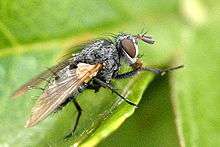Cyzenis albicans
| Cyzenis albicans | |
|---|---|
 | |
| Scientific classification | |
| Kingdom: | Animalia |
| Phylum: | Arthropoda |
| Class: | Insecta |
| Family: | Tachinidae |
| Subfamily: | Exoristinae |
| Tribe: | Goniini |
| Genus: | Cyzenis |
| Species: | C. albicans |
| Binomial name | |
| Cyzenis albicans (Fallén, 1810) | |
| Synonyms[1] | |
| |
Cyzenis albicans is a species of fly in the family Tachinidae.[1] A parasitoid, it lays its eggs on leaves of oak, maple, birch and other trees, so that when the leaves are consumed by the larvae of the host winter moth, the eggs hatch inside the larvae. The fly is native to Europe and Asia but has been introduced into North America in an attempt at biological pest control of the invasive winter moth.
Ecology
Cyzenis albicans is a parasitoid, the female laying its eggs on the surface of leaves which are then eaten by the larvae of suitable host moth species.[2] This fly is synovigenic, continuing to produce and mature eggs throughout its adult life and needing to feed in order to do so.[3] The fly larvae feed internally on the moth larvae, pupating within the moth pupae when their hosts have fallen to the ground, and emerging as adults the following spring.[4]
Hosts
In Europe and Asia, where this fly is native, the larvae of several geometrid moths are parasitised. These include the winter moth (Operophtera brumata), the northern winter moth (Operophtera fagata), the oak nycteoline (Nycteola revayana), the elm autumn moth (Ypsolopha vittella) and the pimpinel pug (Eupithecia pimpinellata).[5]
Use in biological control
The winter moth first appeared in Nova Scotia, Canada, in the 1920s. By 1949 it had spread, causing defoliation of trees on a wide scale, and had been identified as a pest species. In 1954 and 1955, several insect species were introduced from Europe in an attempt to control it. The most successful of these were the parasitic wasp Agrypon flaveolatum and the parasitoid fly C. albicans, both of which became established in Canada.[6] As the numbers of parasites built up, so the populations of the winter moth declined.[6]
Winter moths were first noted in the United States in the late 1990s in the state of Massachusetts. During the next decade they spread from Boston, through Martha's Vineyard and Cape Cod, into Rhode Island, defoliating maples, oaks, fruit trees and other trees. Attempts at biological control followed with the release of C. albicans from 2005 onwards (the wasp was considered unsuitable because of the existence of some rare geometrid moths in the area). The fly has become successfully established in Massachusetts, and the level of parasitism of the moth larvae had reached 20-50% by 2015,[7] after thousands of Cyzenis albicans were released at 17 sites in New England.[8]
In its native range, C. albicans has very little impact on populations of winter moth, and its success in biological control of this invasive pest in Canada and the United States was difficult to predict; soil conditions seem to have been of importance, and there may have been a dearth of natural enemies to prey on the flies, enabling them to become established.[9]
References
- 1 2 Chandler, Peter J. (1998). Checklists of Insects of the British Isles (New Series) Part 1: Diptera. Handbooks for the Identification of British Insects. New Series. 12. London: Royal Entomological Society of London. pp. 1–234. ISBN 0-901546-82-8.
- ↑ Capinera, John L. (2008). Encyclopedia of Entomology. Springer Science & Business Media. p. 4278. ISBN 978-1-4020-6242-1.
- ↑ Jervis, M.A. (2012). Insect Natural Enemies: Practical approaches to their study and evaluation. Springer Science & Business Media. pp. 75–76. ISBN 978-94-011-0013-7.
- ↑ Embree, D.G. (1960). "Observations on the Spread of Cyzenis albicans (Fall.) (Tachinidae: Diptera), an Introduced Parasite of the Winter Moth, Operophtera brumata (L.), (Geometridae: Lepidoptera), in Nova Scotia". The Canadian Entomologist. 92 (11): 862–864. doi:10.4039/Ent92862-11.
- ↑ "Cyzenis albicans (Fallén, 1810)". NBN Atlas. Retrieved December 10, 2017.
- 1 2 Huffaker, C. (2013). Biological Control. Springer Science & Business Media. pp. 109, 169. ISBN 978-1-4615-6528-4.
- ↑ Elkinton, Joseph; Boettner, George; Simisky, Tawny; Swamson, Deborah (March 3, 2017). "Winter Moth in Massachusetts: History and Biological Control". UMass Amherst. Retrieved December 10, 2017.
- ↑ Felicia Gans, Boston Globe Correspondent (November 30, 2015). "Winter moths make appearance for mating season". Retrieved December 3, 2015.
- ↑ Advances in Plant Pathology. Academic Press. 1995. p. 133. ISBN 978-0-08-052678-2.